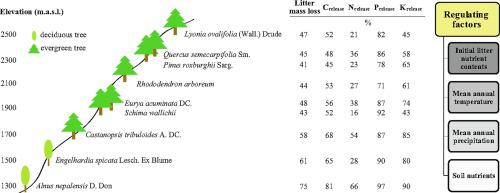Catena ( IF 5.4 ) Pub Date : 2020-06-09 , DOI: 10.1016/j.catena.2020.104698 Meena Bohara , Keshab Acharya , Sabana Perveen , Kiril Manevski , Chunsheng Hu , Ram Kailash P. Yadav , Kamala Shrestha , Xiaoxin Li

|
Litter plays a central role in the nutrient budgets of forests by supplying inflow to nutrient turnover through decomposition. However, studies of litter decomposition and nutrient dynamics in forest ecosystems are limited, particularly for the central Himalaya forest ecosystems with wide importance for stability and nutrient dynamics under global change. A one-year-long in-situ litter decomposition experiment was conducted with multiple tree species, dominating forests along an elevation gradient from 1300 to 2500 meters above sea level (m.a.s.l.) in central Nepal. The main aim was to examine the litter mass loss, factors affecting the decomposition process and the nutrient dynamics of the studied tree species, based on the litter bag method and physico-chemical analyses of the litter and the soil over time. The results showed that litter mass loss decreased with elevation, being the highest at low elevation (63.65%), followed by middle (46.59%) and high elevation (44.48%). The litter from deciduous tree species decomposed more rapidly than that from evergreen species, with Alnus litter decomposing the fastest (1.42 yr−1) and Pinus litter decomposing the slowest (0.53 yr−1), whereas the other species were in the order of Engelhardia > Castanopsis > Eurya > Lyonia > Quercus > Rhododendron > Schima. The contents of carbon (C), nitrogen (N), phosphorus (P) and potassium (K) in the initial litter (i.e., freshly fallen leaves), as well as weather factors (precipitation and temperature) were the best predictors of litter mass loss. The nutrient release from the litter was not discerned throughout the annual decomposition process, however, the release rate at the end of the study period followed the order of P > K > C > N, indicating that litter is a potential sink of N due to its slow release rate. This study may serve as a baseline for long-term research on nutrient dynamics in forest ecosystems of central and eastern Himalaya, which is imperative for preserving biodiversity and ecosystem stability and for mitigating climate change impacts.
中文翻译:

喜马拉雅山中部沿海拔梯度原木凋落物分解和养分释放
凋落物通过分解为养分周转提供流入,在森林养分收支中起着核心作用。但是,对森林生态系统中凋落物分解和养分动态的研究非常有限,特别是对于喜马拉雅山中部森林生态系统,这对于全球变化下的稳定性和养分动态非常重要。一年原位在尼泊尔中部,从海拔1300至2500米的海拔高度的梯度森林中,对多种树木进行了凋落物分解实验。主要目的是基于垃圾袋法以及随时间推移对垃圾和土壤进行的理化分析,研究垃圾质量损失,影响研究树木物种分解过程和养分动态的因素。结果表明,凋落物质量损失随海拔升高而降低,在低海拔处最高(63.65%),其次是中海拔(46.59%)和高海拔(44.48%)。落叶树种的凋落物分解速度比常绿树种的分解速度更快,其中nu木凋落物分解最快(1.42 yr -1)和松树分解凋落物分解最慢(0.53 yr -1),而其他物种则依次为Engelhardia> Castanopsis> Eurya> Lyonia> Quercus> Rhododendron> Schima。初始凋落物(即新鲜落叶)中碳(C),氮(N),磷(P)和钾(K)的含量以及天气因素(降水和温度)是最好的预测凋落物的指标。质量损失。凋落物的养分释放没有在整个年度分解过程中被发现,但是,研究期结束时的释放速率遵循P> K> C> N的顺序,这表明凋落物是氮的潜在汇聚源。它的释放速度慢。这项研究可以作为喜马拉雅中部和东部森林生态系统中养分动态长期研究的基线,这对于保护生物多样性和生态系统稳定以及减轻气候变化的影响至关重要。











































 京公网安备 11010802027423号
京公网安备 11010802027423号